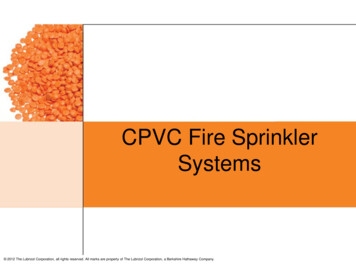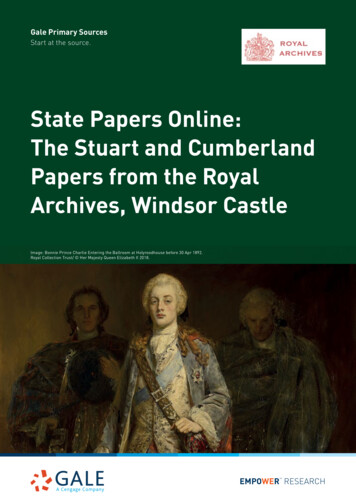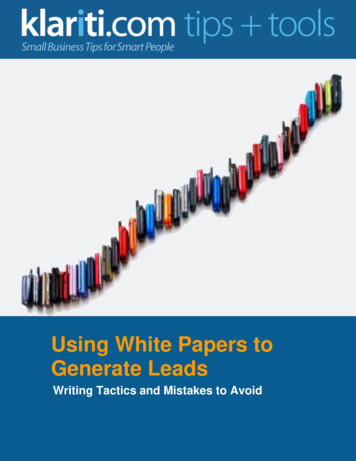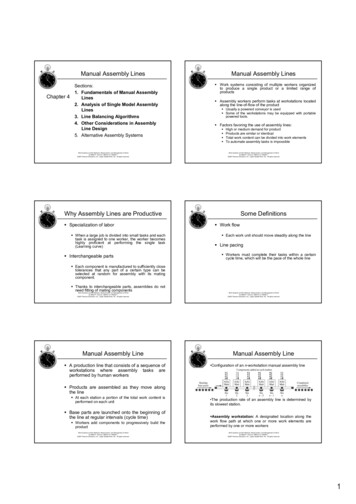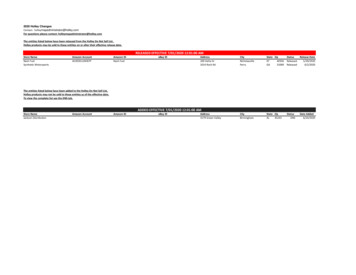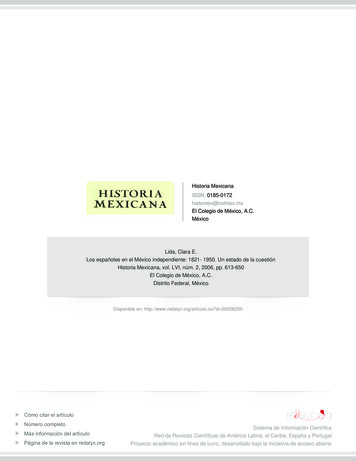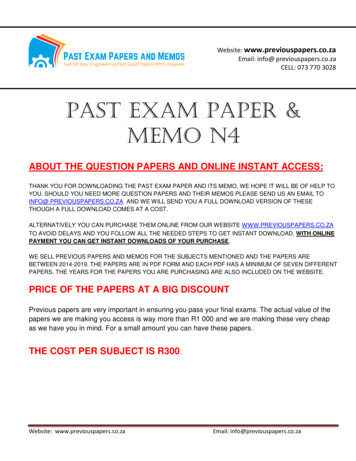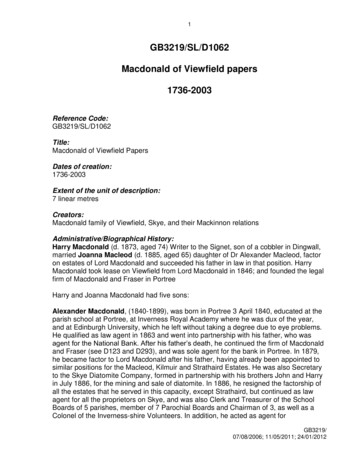
Transcription
General Assembly Papers, 1821-1870General AssemblyState Archives Record Group No. 002HistoryThe General Assembly is Connecticut’s legislative body. Its foundation dates back to a commissiongranted by the Massachusetts General Court giving eight leaders the right “to govern the people atConnecticutt”[sic] for the year beginning in March 1636. The Fundamental Orders of 1639 provided aframe of government for the infant Connecticut Colony and granted the freemen the right to elect agovernor, six magistrates, and four deputies from each of the three towns then in existence. As new townswere organized, the number of deputies and magistrates increased. The Charter of 1662 provided for theelection of a governor, deputy governor, twelve assistants, and two representatives from each town.In March 1662/63 and on several other dates, the General Court passed acts allowing a group ofassistants to act for the colony in emergencies when the General Court was not in session. The assistantsserved as the governor’s council and, by an act of October 1698, became the Upper House, while thedeputies elected by the freemen of the towns constituted the Lower House. After this formal separation ofthe two bodies, all legislation required the concurrence of both houses, although the General Court hadresolved as early as February 1644/45 that “no act shall passe or stand for a law, wch is not confirmed bythe major part of the said Magistrats, and by the mayor [sic] prte of the deputys there prsent in Court.”For many years the General Court or General Assembly, as it became called, also served as thecolony’s and later the state’s highest court. Separate lower courts were, however, established: theParticular Court, 1638; Court of Assistants and County Courts, 1665-66; separate probate courts, 1698;the Superior Court, 1711; and the Supreme Court of Errors, 1784. The Constitution of 1818 establishedthe specific separation of judicial, executive, and legislative powers.1The present Constitution, adopted in 1965, provides for a Senate of 30 to 50 members and a House ofRepresentatives of from 125 to 225 members. The General Assembly currently consists of 36 senators and151 representatives. Electors in each senatorial and assembly district choose members for two-year terms.The legislature holds regular length sessions in odd-numbered years and shorter sessions in evennumbered years. It conducts its business through a system of joint committees comprised of members ofboth houses, a practice that dates back well over 150 years.Scope and ContentThe General Assembly Papers begin in the year 1803 and continue into the 1990s. They consist ofrecords that follow chronologically what are commonly called the “Connecticut Archives.”2 The papersdescribed here cover the years 1821-1870, although they include two fugitive documents from 1803 and1813, relating to the Milford and Stratford Bridge Company and the Washington Bridge Company (Box1, folder 1). The 1870 closing date was chosen because it was about the time of the end of post-Civil Warlegislation to promote civil rights and to provide care for disabled veterans.1For additional information on early Connecticut courts, see the descriptive register to RG 003, JudicialRecords.2Sylvie J. Turner, “The Connecticut Archives,” Connecticut Historical Society Bulletin 33 (July 1968):81-89.- 1-7/14/99
State Archives Record Group No. 002Subgroup No. 000The Papers consist of petitions, memorials, remonstrances, affidavits, resolutions, public acts, annualreports, reports of legislative committees, gubernatorial messages, and other official papers that documentthe activities of the General Assembly, Connecticut municipalities, corporate bodies, and manyindividuals.The General Assembly Papers are arranged chronologically by year and then by number under avariety of subjects. Folder titles reflect both contemporary practice and the need to provide guidance toresearchers. The numbering system was established in the 1970s and presumably reflects the arrangementof the papers at that time. It is impossible to determine how extensively the original order of these paperswas altered between the time of their creation and boxing and numbering in the 1970s. Some numbersare missing. It is often not known if the items have disappeared, were transferred to other files, ornumbering errors have occurred. Missing numbers are listed on the folders where they should appear.A wide variety of subjects are covered in the General Assembly Papers, from those of only localimport to those of national interest. National and federal-state relations issues are generally found in filesidentified by the phrase, Federal Relations. These files typically contain printed resolves from variousstates, often accompanied by resolutions of the General Assembly, urging Congress to pass newlegislation, proposing constitutional amendments, or expressing opinions on such subjects of nationalimportance as internal improvements, the protective tariff, gradual emancipation, colonization,nullification, sale of western lands, the constitutionality of the national bank, the admission of Texas, freesoil, and the integrity of the Union. In 1825, for example, resolutions from several states were forwardedto Connecticut on the subject of gradual emancipation and colonization (Box 6, folder 15). At its 1830session, the General Assembly registered its opposition to a Missouri proposal to directly elect thepresident and vice-president (Box 13, folder 12). The General Assembly passed a resolution in 1834supporting the Bank of the United States and opposing President Jackson’s veto of its recharter (Box 20,folders 3, 5-6) In early 1861 after the secession of six states from the Deep South, to cite a final example,Connecticut received resolutions from eleven states seeking ways to preserve the union from furtherdestruction (Box 96, folders 3-5). The Federal Relations files should be of particular value to researchersinterested in the ways national issues impacted upon Connecticut and the ways the states tried to exertinfluence on Congress.Internal improvement and transportation issues occupied a great deal of the General Assembly’s timeand the Transportation Revolution of the nineteenth century is well documented. Numerous turnpike,canal, ferry, bridge, railroad, and horse railroad companies were incorporated between 1821 and 1870.These companies have long since disappeared and the records of virtually all of them are no longer extant.The General Assembly Papers, therefore, provide prime documentation on developments in an importantera of American history. Articles of incorporation, amendments to charters, requests for specialprivileges, and a variety of other papers about scores of large and small transportation companies arefound throughout the General Assembly Papers. These materials have relevance not only for thoseinterested in larger issues like the rise and decline of turnpikes in Connecticut and the growth of therailroad industry, but also for those studying smaller transportation companies in particular localities orregions. Examples of smaller companies include the New York and Sharon Canal Company, HadlymeTurnpike Company, Pettipaug and Guilford Turnpike Company, Mill Cove Bridge Company (NewLondon), New Haven and New London Railroad Company, South Manchester Rail Road Company, andthe New Haven and West Haven Horse Railroad Company.The era between 1821 and 1870 can also be considered the Age of Incorporation, as the GeneralAssembly chartered hundreds of organizations serving a variety of commercial, fraternal, and benevolentpurposes. The General Assembly Papers, particularly for the period after 1830, contain extensive files ofpetitions, memorials, articles of incorporation, drafts of general legislation, and other similar papersdocumenting the establishment and development of commercial banks, insurance companies, savingsbanks, mining companies, manufacturing companies, fire engine companies, ecclesiastical societies,-2-7/14/99
State Archives Record Group No. 002Subgroup No. 000agricultural societies, benevolent societies, park associations, fraternal organizations, cemeteryassociations, educational institutions, and other similar organizations. The papers provide information onsuch corporate bodies as the Union Manufacturing Company of East Haddam incorporated in 1831, theMansfield SilkDoc. 1: Public Act, 1821-3-7/14/99
State Archives Record Group No. 002Subgroup No. 000Manufacturing Company founded in 1832, Essex Fire Engine Company (1833), The Proprietors of theNew Burial Ground in Greenwich (1833), Wadsworth Athenaeum (1842), St. Patrick’s Society ofHartford (1842), First Baptist Society of Middletown (1844), The Connecticut Fire Insurance Company(1850), and Connecticut Temperance Life Insurance Company (1851). Additional examples include theCheney Brothers Silk Manufacturing Company (1854), the Trustees of the Aged and Infirm Clergy andWidows Fund (1855), Colts Patent Fire Arms Manufacturing Company (1855), Colchester Bank (1856),The Hebrew Literary and Social Union (1863), Fitch’s Home for Soldiers (1865), Young Men’s ChristianAssociation of Meriden (1866), St. Mary’s Catholic Total Abstinence Beneficial Society (1867),Woodland Park and Cemetery Association (1868), and the Fat Man’s Association (1870).The papers provide a great deal of information on municipalities. To cite just three examples fromthe 1853 session of the General Assembly, an act was passed “Extending the Limits of the City ofHartford” (Box 69, folder 8), the Borough of Colchester was incorporated (Box 68, folder 13), and a highschool established in Norwich (Box 68, folder 13). The General Assembly Papers contain material onsuch subjects as the incorporation of new towns, cities, and boroughs, revisions to borough and citycharters, education, economic development, and the growth of social institutions. Numerous petitionsfrom individuals in towns ask for legislative action on state-wide issues. In 1830, for example, theGeneral Assembly received petitions from inhabitants of eleven towns opposing lotteries. Three yearslater, in response to the controversy surrounding the Prudence Crandall School, a number of communitiesexpressed their opposition to educating “people of color . . . from other States” (Box 18, folder 3). At thesame session, citizens from New Haven petitioned to prevent the hunting of “feathered game” betweenFebruary and July. The 1853 General Assembly was flooded with petitions from more than thirty townsurging passage of temperance legislation. The next year the General Assembly passed “An Act for theSuppression of Intemperance” (Box 70, folder 3), that in part addressed the concerns of the temperancepetitions.Lives of individuals are much less well documented and what exists is difficult to find. Petitions frompersons seeking legislative favor are found in such files as those on State Prison Releases, Forfeited RightsRestored, Sale of Lands, Divorces, Lands, and Estates. Only a handful of such cases are, however, dealtwith by the General Assembly in any given year. Many petitions, however, contain the names of scores ofpeople. Signatures on a temperance petition, for example, provide important information about the beliefsof those who sign them. One such 1845 memorial from inhabitants of Millington Society in East Haddamincludes the signatures of six Starks. The headings for Schools and School Districts sometimes list thenames of all enrolled students. Many petitions, memorials, and remonstrances, then, contain the names ofnumerous signers, but even if one knows the relevant town or municipality, there is no certainty that apetition will exist for the time frame of interest or that the people searched for will be included. Inaddition, researchers may have to laboriously search through a number of boxes before finding a possiblyrelevant document. Occasionally, however, an issue arises of such broad interest that the inhabitants feelvirtually obligated to express an opinion. One such controversy occurred in 1865 over the New LondonCounty court house, between adherents of Norwich as the single site for sessions of the Superior Court andSupreme Court of Errors and those who favored the existing dual New London and Norwich locations(Boxes 106-07). One petition from Norwich in favor of the change was signed by 1,910 males, while tworemonstrances from New London contained more than 3,000 signatures.The General Assembly Papers include important, although widely scattered, information on minoritycommunities in Connecticut. Many researchers have examined the materials on African-Americans andNative-Americans and some of these documents have become tattered with use. All these materials,therefore, have been photocopied and photocopies have been inserted in place of the originals. Separatecontainers house second copies of these documents. The originals of these papers have been restricted andresearchers may examine them only if they need to photograph or scan them and then only with thepermission of the State Archivist.-4-7/14/99
State Archives Record Group No. 002Subgroup No. 000The state’s small Indian population is relatively well documented because Native-Americans hadtribal status and legislative approval was required before any tribal lands could be sold. Researchersstudying the Mohegan, Niantic, Golden Hill Paugussett, Turkey Hill Paugussett, Eastern Pequot,Mashantucket Pequot, and Schaghticoke tribes will find relevant materials in the General AssemblyPapers. Connecticut’s vibrant African-American community by contrast is much less well documented.The files contain a total of eight petitions from 1838, 1842, and 1857 asking for educational benefits, jurytrials for suspected fugitive slaves, and for the right to vote. Much of the remaining material consists ofpetitions and accompanying documents from individuals asking for release from state prison. In 1841Joel Freeman and eleven others from Bridgeport petitioned to establish a school district “exclusively forcolored Children” (Box 33, folder 14) and subjects such as care for the indigent are sometimes addressed.Connecticut’s Irish, German, and Jewish communities are documented, primarily through petitionsseeking to incorporate fraternal and benevolent societies, such as the Hibernian Provident Society (1850)and the Hartford Turner & Singing Society (1864).The business of the state legislature did not, however, consist just of responding to petitions,redressing grievances, granting charters of incorporation, and giving its views on national political issues.The bulk of the work of the General Assembly concerned civil and military appointments, specificresolutions authorizing the expenditure of state funds, drafting and passing public acts, crafting reports,and receiving annual reports from state agencies and a variety of corporate bodies, not to mention theroutines of legislative organization. The General Assembly expressed its desire to promote economicdevelopment through the granting of charters to scores of transportation companies, commercial banks,savings banks, insurance companies, and manufacturing concerns. It also, however, established stateboards and commissions to provide oversight over the insurance, banking, and railroad industries andpassed acts to provide a measure of regulation of them. In 1865, for example, the state legislature passed“An Act relating to the Location of Railroad Stations in certain Cases” (Box 107, folder 18) and “An Actfor the Protection of Life at Railroad Crossings (Box 108, folder 1). The next year it passed a resolutionasking the Railroad Commissioners to inquire if railroads were in the habit of halting freight trains onpublic highways “to the annoyance of the traveling public” (Box 109, folder 1). The records of theGeneral Assembly can also be used to track changes in attitudes towards juvenile offenders, care of thementally incompetent and insane, capital punishment, public education, destruction of the environment,lotteries, alcohol consumption, agriculture, the powers of municipalities, the role of the judiciary, andhonoring patriots and Civil War veterans.The preceding paragraphs should give researchers an idea of the rich variety of subjects that can bestudied in the General Assembly Papers between 1821 and 1870. During this period, the powers andresponsibilities of state government gradually expanded and private initiatives to promote communitygood or ameliorate the conditions of the less fortunate in society were the hallmarks of the age ofbenevolence.ProvenanceThe General Assembly Papers came to the archives by transfers from the office of the Secretary ofState, the constitutional office responsible for the “safe-keeping and custody of the public records anddocuments.”Related RecordsAs has been previously noted, the General Assembly Papers are the successor records to the“Connecticut Archives,” 1629-1820, part of Record Group 1, Early General Records. Rejected Bills,-5-7/14/99
State Archives Record Group No. 002Subgroup No. 0001808-1899 are closely associated with the General Assembly Papers. Many items found in Rejected Billswere later passed by the General Assembly. In 1813, for example, the inhabitants of the Second Society inGroton petitioned for township privileges, but the town of Ledyard was not incorporated until 1836. Kentpetitioned to be set off as a separate probate district in 1824. The town achieved this goal in 1831.Researchers looking for information on a wide variety of subjects, therefore, need to consult Rejected Billsin addition to General Assembly Papers.The General Assembly Papers include drafts of public acts (Public Acts, Original Bills) and finalengrossed versions of the same acts for a number of years (Public Acts, Engrossed Bills). The engrossedversions of public acts contain the signatures of the governor, speaker of the house, and president of thesenate, usually the lieutenant governor. Public acts and other official records of the General Assemblycomprise the Records of the State of Connecticut. Volumes 13-42 cover the period between 1821 and1870. Printed copies of many reports of state agencies and commissions can be found in ConnecticutDocuments. For other related materials, see Engrossed Bills, 1859-1986; House and Senate journals; andprivately printed state registers.Access NoteResearchers accustomed to the detailed indexing of the Connecticut Archives will find the GeneralAssembly Papers cumbersome to use. In many instances, the only choice is to plow systematicallythrough each box and folder for the relevant time frame. Needed items may sometimes be located inunlikely files. On rare occasions, related materials on the same person or subject can be in two or morelocations. The collection does, however, include two boxes of lists of dockets and petitions covering mostof the years between 1810 and 1903 (Boxes A and B). The petitions may be submitted by individuals,municipalities, or corporate bodies. They are listed in numerical, not alphabetical, order and are generallydivided into sections for continued petitions and new petitions. Sometimes it is possible to discern subjectfrom a petition title, like “Norwich & Preston Bridge Co. Petition” (May 1823), but in other cases this isnot possible. See, for example, “Moses Warren’s Mem[oria]l” (May 1824). The indexes in these twoboxes can, therefore, be of help, but not all memorials were favorably acted upon and, thus, researchersmust also look in Rejected Bills. Moreover, not all legislation began with a petition to the GeneralAssembly.-6-7/14/99
State Archives Record Group No. 002Subgroup No. 000Act of incorp. of Hartford Female Seminary, 1827-7-7/14/99
State Archives Record Group No. 002Subgroup No. 000Container Listing1.2.3.4.5.6.1803Milford and Stratford Bridge Company (folder 1)Box 1Washington Bridge Company (folder 1)Box 1Acts, Resolutions, etc.: Public Acts, Engrossed, Appointments, Orders on theTreasurer, Reports, etc.3 (folders 2-7)Reports and Miscellaneous Documents: Canvassers Reports, Resignations,Committee Appointments, Military Returns, etc. (folders 8-12)Petitions and Resolves Thereon: Turnpikes, Estates, Divorces, Lands, etc. (folders13-15)Petitions and Resolutions Thereon: Towns, Cities, and Boroughs, Turnpikes,Schools, Fisheries, Military Affairs, Incorporations, etc. (folders 17-20)Reports and Resolutions: Federal Relations, etc. (folder 21)Box 1Appointments, Acts, and Resolves: Lands, Sale of Lands, Turnpikes, Schools,Incorporations, etc. (folders 1-5)Reports and Sundry Documents: Military Affairs, Federal Relations, Navigation,Turnpikes, Governor’s Messages, etc. (folders 6-10)Petitions and Resolves: Military Affairs, Incorporation of Banks, Appointments,etc.(folders 11-14)Petitions and Resolutions Thereon: Turnpikes, Incorporations, Schools, Towns,Cities and Boroughs, Farmington Canal, etc. (folders 15-21)Box 2Petitions and Resolves (Part 1): Sale of Lands, Turnpikes, Divorces, etc. (folders1-4)Petitions and Resolves (Part 2): Incorporations, Manufacturing Companies,Turnpikes, Towns, Cities, and Boroughs, Military Affairs, etc. (folders 5-8)Petitions and Resolves (Part 3): Navigation, Contested Election, Schools, ProbateDistricts, Lands, Divorces, etc. (folders 9-12)Acts, Resolves, etc.: Appointments, Public Acts Engrossed, etc. (folders 13-17)Reports, Resignations, and Miscellaneous: Federal Relations, Liquor Traffic,Canvassers, Governor’s Messages, etc. (folders 18-19)Box 3Reports, Resignations, and Miscellaneous: Federal Relations, Liquor Traffic,Canvassers, Governor’s Messages, etc. (folders 1-3)Box 418131821182218231824Petitions and Resolves Thereon (Part 1): Probate Districts, Incorporations,Manufacturing Companies, Towns, Cities, and Boroughs, Turnpikes, etc.(folders 4-8)3Etc. is used to indicate that materials on additional subjects are included, although such subjects are lesssignificant than those listed.-8-7/14/99
State Archives Record Group No. 002Subgroup No. 000Petitions and Resolves Thereon (Part 2): Prison Releases, Turnpikes, Navigation,Sale of Lands, Lands, etc. (folders 9-13)Reports and Miscellaneous: Military Affairs, Canvassers, Governor’s Messages,etc.(folders 14-18)Resolutions, Appointments, etc. (folders 19-20)Resolutions, Appointments, etc. (folders 1-2)Public Acts: Original Bills, Engrossed Bills (folders 3-6)7.Box 51825Civil and Military Appointments, Military Resignations, Reports (folders 7-12)Petitions and Resolves (Part 1): State Prison Releases, Manufacturing Companies,Turnpikes, Navigation, Bridges, Schools, etc. (folders 13-18)8.Petitions and Resolves (Part 2): State Prison Releases, Probate Districts, FishingLaws, Turnpikes, etc. (folders 1-4)Petitions and Resolves (Part 3): Estates, Expenses Reimbursed, Schools, Sale ofLands, etc. (folders 5-9)Petitions and Resolves (Part 4): Incorporations, Insurance, ManufacturingCompanies, Steamboat Companies, Benevolent and Religious Societies, etc.(folders 10-13)Reports and Miscellaneous Papers: Newgate Prison, Federal Relations, Governor’sMessages, Banks, Canvassers, etc. (folders 14-18)Box 6Public Acts: Original Bills, Engrossed Bills (folders 1-6)Box 71826Petitions and Resolves (Part 1): Sale of Lands, Estates, Incorporations, Turnpikes,Military Affairs, etc. (folders 7-10)Petitions and Resolves (Part 2): Turnpikes, Incorporations, ManufacturingCompanies, etc. (folders 11-14)Petitions and Resolves Thereon: Schools, Expenses Reimbursed, Estates, Divorces,Towns, Cities, and Boroughs, Incorporations, etc. (folders 15-18)Reports, Miscellaneous: Governor’s Messages, Banks, Canvassers, MilitaryReturns, Federal Relations, etc. (folders 1-5)Military Resignations, Civil and Military Appointments (folders 6-10)Public Acts and Resolves: Engrossed Bills, Original Bills, Resolutions, Reports(folders 11-14)9.Box 81827Petitions and Resolves: Divorces, Expenses Reimbursed, Schools, Estates, Sale ofLands, State Prison Releases, etc. (folders 15-21)Petitions and Resolves Thereon: Incorporations, Turnpikes, EducationalInstitutions, Towns, Cities, and Boroughs, Sale of Lands, Schools, etc. (folders1-5)Reports: Federal Relations, Canvassers, Banks, etc., and Governor’s Messages(folders 6-9)Civil and Military Appointments, Resignations (folders 10-14)Public Acts and Resolves: Original Bills, Lost Bills, Engrossed Bills (folders 1518)-9-Box 97/14/99
State Archives Record Group No. 002Subgroup No. 00010. 1828Reports and Miscellaneous Papers: State Prison, Governor’s Messages, Banks,State House, Federal Relations, Canvassers, etc. (folders 1-6)Box 10Petitions and Resolves Thereon (Part 1): Schools, Estates, Sale of Lands, Divorces,General Hospital Society, State Prison Releases, Turnpikes, etc. (folders 7-10)Petitions and Resolves Thereon (Part 2): Turnpikes, Incorporations, ManufacturingCompanies (folders 11-14)Original Bills, Miscellaneous Papers: Civil and Military Appointments,Resolutions(folders 15-19)Acts, Resolves, and Petitions: Engrossed Bills, Appointments, Governor’sMessages(folders 1-4)Box 1111. 1829Petitions and Resolves Thereon (Part 1): Turnpikes, Incorporations, Divorces, Saleof Lands, Estates, Schools, etc. (folders 5-9)Petitions and Resolves Thereon (Part 2): Incorporations, Schools, State PrisonReleases, Fire Companies, Expenses Reimbursed, Sale of Lands, etc. (folders10-14)Reports, Resignations, and Miscellaneous: Humane Institutions, Education, StateHouse, Governor’s Messages, Military Affairs, Banks, etc. (folders 15-18)Reports, Resignations, and Miscellaneous: Humane Institutions, Education, StateHouse, Governor’s Messages, Military Affairs, Banks, etc. (folders 1-2)Public Acts and Resolves: Civil and Military Appointments, Original Bills,Engrossed Bills, Canvassers Reports (folders 3-8)Box 1212. 1830Petitions and Resolutions (Part 1): Turnpikes, Probate Districts, Lotteries,Divorces,etc. (folders 9-12)Petitions and Resolutions (Part 2): Schools, Turnpikes, Estates, Sale of Lands, StatePrison Releases, Expenses Reimbursed, etc. (folders 13-16)Petitions and Resolves Thereon: Schools, Fire Companies, Incorporations, Towns,Cities, and Boroughs, etc. (folders 17-19)Petitions and Resolves Thereon: Schools, Fire Companies, Incorporations, Towns,Cities, and Boroughs, etc. (folder 1)Reports: Federal Relations, State Prison, General Assembly Committees,Canvassers, Banks, Governor’s Messages, State House, etc. (folders 2-7)Public Acts and Resolves: Appointments, Engrossed Bills, Original Bills (folders8-11)Public Acts, Resolves, Civil and Military Appointments (folders 12-15)An Act Concerning Crimes and Punishments (folders 16-19)Box 13Reports and Miscellaneous Documents (Part 1): Federal Relations, Appointments,State Prison (folders 1-4)Box 1413. 1831- 10 -7/14/99
State Archives Record Group No. 002Subgroup No. 000Reports and Miscellaneous Documents (Part 2): Federal Relations, Canvassers,Appointments, Military Affairs, Banks, (folders 5-8)Petitions Granted: Farmington Canal, Probate Districts, Banks, Schools, etc.(folders9-11)Public Acts and Resolves: Incorporations, Manufacturing Companies, InsuranceCompanies, Schools, Towns, Cities, and Boroughs, Fire Companies, Turnpikes,etc. (folders 12-16)Public Acts, Resolves, Petitions Granted: Original Bills, Engrossed Bills (folders17-18)1832 Sharon & Salisbury Rail Road Company petition- 11 -7/14/99
State Archives Record Group No. 002Subgroup No. 000Public Acts, Resolves, Petitions Granted: Original Bills, Engrossed Bills(folders 1-3)Petitions Granted by Resolution: Probate Districts, School Fund, Banks, YaleCollege, State Prison Releases, Pensions, Bridges, Divorces, etc.(folders 4-8)Box 1514. 1832Resolutions and Petitions Granted (Part 1): Incorporations, Railroads, Schools,Turnpikes, etc. (folders 9-11)Resolutions and Petitions Granted (Part 2): Estates, Sale of Lands, Incorporations,State Prison Releases, Schools, etc. (folders 12-16)Petitions Granted and Resolves Thereon: Incorporations, Fire Engine Companies,Manufacturing Companies, Insurance Companies, Turnpikes, etc. (folders17-19)Petitions Granted and Resolves Thereon: Incorporations, Fire Engine Companies,Manufacturing Companies, Insurance Companies, Turnpikes, etc. (folder 1)Petitions for School Money, Civil and Military Appointments, etc.(folders 2-6)Reports: Agents of the Eagle Bank, Joint Committees, Canvassers, Banks, StatePrison, etc. (folders 7-11)Public Acts and Resolutions: Original Bills, Engrossed Bills (folders 12-16)Resolutions, Public Acts, Miscellaneous Documents: Prison Releases, Towns,Cities,and Boroughs, Divorces, Federal Relations, Governor’s Message, Estates,Lands, etc. (folders 17-21)Box 16Reports: Joint Committees, Canvassers, Banks, Military Returns, Governor’sMessage, etc. (folders 1-6)Reports No. 2: Judiciary Committee, Lotteries, etc. (folder 7)Petitions and Resolutions: State Prison Releases, Divorces, Incorporations, FireCompanies, Benevolent Societies, Turnpikes, etc. (folders 8-11)Petitions Granted by Resolution: Incorporations, Manufacturing Companies, etc.(folders 12-15)Petitions for Public Acts and School Money: Estates, Sale of Lands, Turnpikes,StatePrison Releases, Banks, Education of African-American Females, etc. (folders16-19)Box 17Petitions for Public Acts and School Money: Estates, Sale of Lands, Turnpikes,State Prison Releases, Banks, Education of African-American Females, etc.(folders 1-3)Reports: Railroads, Lotteries (folder 4)Civil Appointments, Petitions Granted by Resolution, etc.: State Prison, JointCommittees, Canvassers, Estates (folders 5-9)Public Acts and Resolutions (Part 1): Original Bills, Engrossed Bills, FederalRelations (folders 10-14)Public Acts and Resolutions (Part 2): Engrossed Bills, Original Bills (folders 1521)Box 18Governors’ Messages and Accompanying Documents: Federal Relations,Miscellaneous Matters (folders 1-5)Box 1915. 1833- 12 -7/14/99
State Archives Record Group No. 002Subgroup No. 00016. 18
The General Assembly Papers, therefore, provide prime documentation on developments in an important era of American history. Articles of incorporation, amendments to charters, requests for special privileges, and a variety of other papers about scores of large and small transportation companies are found throughout the General Assembly Papers.
